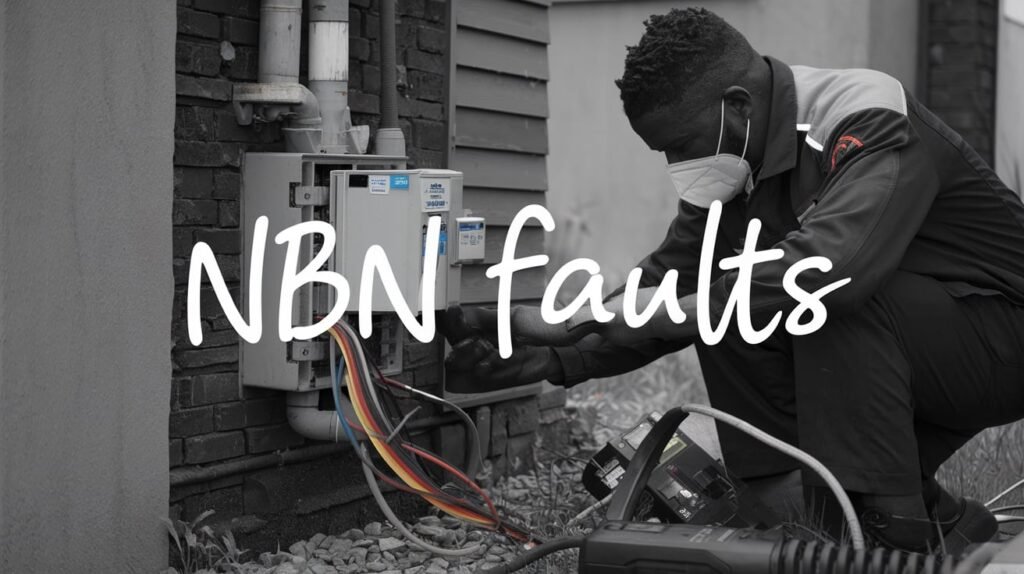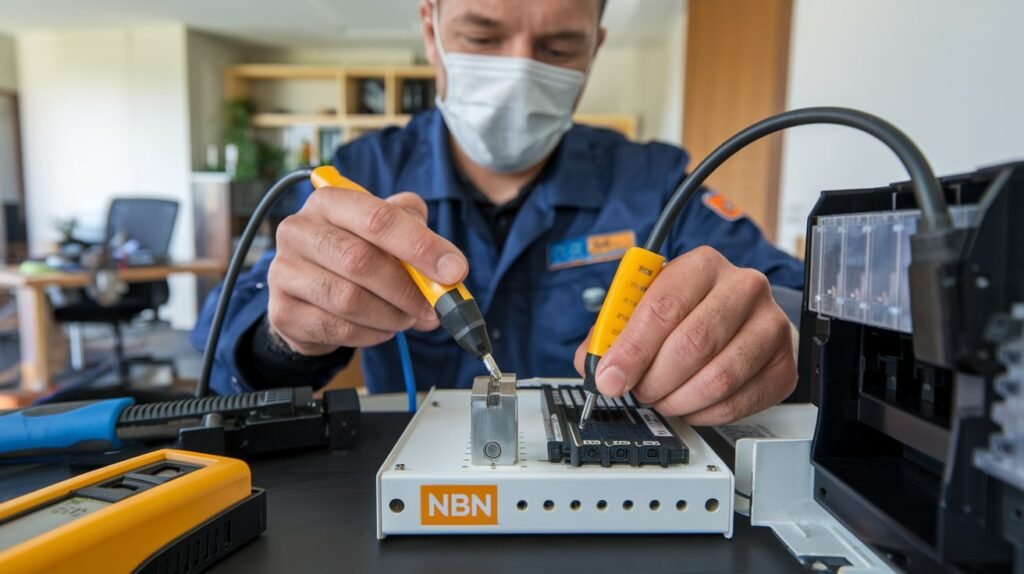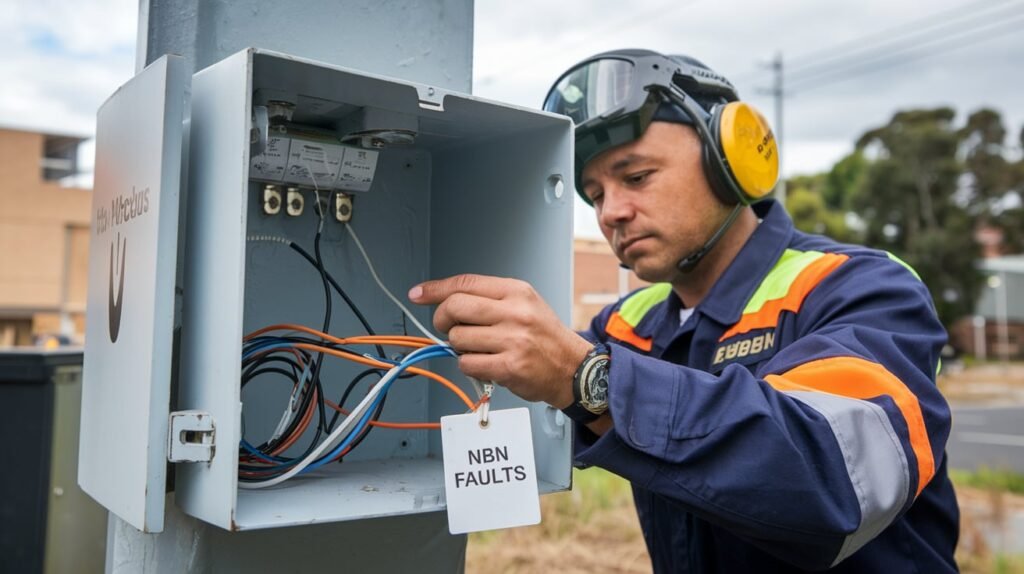The National Broadband Network (NBN) revolutionized internet access to millions of Australians. Yet, despite the many advantages, NBN faults can disconnection and productivity. This guide assesses several such faults, probable causes, and existent solutions to help you retain that healthy state.

Table of Contents
What Are NBN Faults?
In simple terms, NBN faults have the way to define the problems or interruptions created in the National Broadband Network, which serves as the backbone of Australia‘s internet services. The fault can affect your internet connection, ranging from slow connection speeds to total unavailability of the server. By knowing the general faults, you can identify and treat them properly.
Most Frequent Cause Of Disruption With NBN
- No Link to the Internet
- Complete loss of connectivity, where none of the devices is at all able to get any form of internet connection. This suggests a fault either at the level of the service provider, at home equipment or there might be something wrong in the NBN network itself.
- Slow Internet
- Less speed than promises on your plan. Sometimes it is caused by a fault, at peak times, between some misconfigured connections or even faulty equipment. It happens quite often.
- Frequent Dropouts
- Dropouts occur when your internet connection does not provide ongoing or uninterrupted connectivity. Possible sources of these dropouts include line interference, faulty hardware, or failures in NBN infrastructure. Dropouts are particularly annoying if one is making video calls, streaming, or similar.
- Hardware Malfunction
- The following are some problems that may cause NBN dropouts – faults related to your NBN connection box, modem and router. Faulty or outdated equip usually needs to be replaced or repaired to restore a stable connection.
- Local Disconnection
- Very seldom, NBN faults are due to area-wide cutbacks such as services being carried out, normal weather events, or tech failure in the network. All these occurrences are usually beyond the control of the individual and require fixing from NBN Co or the service provider.

Common Causes of NBN Faults
It makes it possible to troubleshoot and address the problems with connectivity effectively by knowing the reasons behind the NBN faults. Following is a sufficient explanation about the typical causes:
- Network Congestion
- At certain peak times, such as every evening with people being online most of the time, the network gets choked with traffic. On a normal basis, the speed may drop grossly as there is currently limited bandwidth that can be shared among users in the area. Service providers would especially call it busy hour slowdown.
- Faulty Hardware
- Modems, routers, and the NBN connection devices (like the NBN box) can stop functioning at a point in time in their lifecycle due to wear and tear, outdated firmware, or physical damage. Usually, faulty hardware leads to inconsistent Internet speed, with frequent dropouts, or no connection at all.
- Cabling Issues
- Damaged, degraded, and poorly installed cables either within your home or NBN at large can cause disruptions. Some are:
- Old copper lines in FTTN (Fibre to the Node) connections may struggle to meet current data demand.
- Signal strength and stability can be affected by loose connections or cable breaks.
- Damaged, degraded, and poorly installed cables either within your home or NBN at large can cause disruptions. Some are:
- Incorrect Setup
- Installing pieces of equipment inappropriately, plugging some wires into the wrong ports, using incompatible devices, or poorly positioning your router can make you suffer from dropouts and performance issues most often. Correct setup is essential for a reliable connection.
- Weather Conditions
- Extreme weather, such as storms, floods, or high winds, destroys outdoor infrastructure, including cables and nodes. For example, consider the following:
- Heavy rains cause water activity below ground to seep into the underground cables and then degrade the signal.
- Lightning strikes damage equipment, followed by needing to be repaired by NBN Co.
- Extreme weather, such as storms, floods, or high winds, destroys outdoor infrastructure, including cables and nodes. For example, consider the following:
How to Identify NBN Faults
NBN identifies the faults in your network; however, these are simple procedures to follow. Here is an example of troubleshooting and diagnosing a few of the common problems you may have with your connection:
Step 1: Check Your Modem or Router Lights
- The modem and/or router indicator lights display the status of the Internet connection. Most devices have just three indicator lights showing the power, connection status and data transfer.
- Green or Blue light: normal, everything normally works
- Orange or Red light: A probable problem, such as connection failure or authentication issue.
- No light: possible power fault, device may be faulty or the whole connection may be lost.
- Therefore, these lights give you an immediate idea if the fault is from your equipment or the connection itself.
Step 2: Validate if the Problem is Within the Parameters of Your House or a Larger Outage
- That’s right. If the modem or router is working perfectly well and the internet connectivity is still absent, it could be either a localized issue or a bigger network outage.
- To check:
- Ask family members or housemates if they are facing the same thing.
- Check with your provider: Visit your service provider’s website or call to check on the area outages. Most providers have an outage map or notifications confirming it.
- You can also ask your neighbors if they are facing the same issues.
Step 3: Run an Online Speed Test to Measure Your Connection Speed
- A speed test is a pretty simple method for checking the ability of your connection. You can either find your own websites or you can use Speedtest by Ookla.
- Download speed and upload speed: Compare these results with what your NBN plan promises.
- Latency (ping): High latency indicates something mishap with the network, congesting a network or even probably with something in the NBN as a whole.
- However, if the speeds are much lower than expected, it refers to congestion issues, line quality, or a hardware malfunction.
Step 4: Inspect Physical Hardware: Check for Damages or Incorrect Setup.
- Usually physical damages or improper setups cause NBN faults.
- Check your cables: Check all cables, including power, Ethernet, and phone lines, to confirm that they are tightly secured and not damaged.
- Check NBN Box and Modem: Check whether the box and modem have cracks, burnt areas, or signs of overheating.
- Ensure Proper Placement: Ensure that your modem is not buried under clutter that can obstruct airflow and eventually result in effect overheating.
- Double Check Set-up: Check if it is properly set up and configured for your modem or router. Refer to your user manual or reset your devices if not sure.

Common NBN Faults Fixes
These steps refer to completing a number for troubleshooting processes in fixing NBN faults. Below are some of the common issues:
1. No Internet Connection
The following steps will help if there is no internet access:
- Restart Both Modem and Router: Power both modem and router off and leave them turned off for about half a minute before powering them back on. This clears temporary glitches or issues caused by overloaded devices.
- Check NBN Outage Maps for Reported Disruptions: Some issues are beyond the confines of the individual house. Check your provider’s outage map or website for service disruptions in your area.
- Call Your ISP for More Help: Otherwise, if you’ve restarted all the equipment, and it hasn’t found any outages, you should contact your Internet Service Provider (ISP) for extra help. You could perform some remote diagnostics to check your line or NBN Faults connection.
2. Slow Internet Speeds
If your internet is slower than what should be expected:
- Disconnection of Unused Devices on the Network: Too many devices being connected to the network will also slow down high-speed networks during peak times. Disconnect any of the devices that are not in use.
- Upgrade Your Plan to a Higher Speed Tier: If this is always the case and the speed is below what you expected or needed, you should upgrade to a higher plan that will meet the requirements of your usage especially if several people or devices might be online at the same time.
- Ensure Your Modem Supports Your NBN Connection Type: There are different types of NBN connections (FTTP, FTTN, etc.), and as such, the equipment you need is different. Make sure your modem/router is compatible with your specific connection type.
3. Frequent Dropouts
Try the following solutions:
- Centralize Your Modem in Your Home: Place your modem on a central position away from walls and heavy furniture to cater for a wider coverage area. Poor placement could instead lead to poor signals.
- Conservative Equipment Replacement: Faulty or old cables could include dropouts. Ensure all cables are in good condition and properly connected. It includes ethernet, power, and telephone lines.
- Factory Resetting Modem: Lastly, factory reset the modem. It will fix any issues caused by incorrect configuration or the software vending bugs. Be advised that you would require setting it up again.
4. Hardware Fails in Action
Malfunctioning hardware: this is what action must be taken:
- Check for Firmware Updates on Your Modem/Router: check if your firmware is up to date because manufacturers continuously provide firmware updates to fix bugs and improve performance on devices. Check your for settings or refer to your user manual for updates on how to update.
- Replace Faulty Hardware as Recommended by Your ISP: Contact your ISP for recommendations on replacing defective hardware if all the above-the-mold solutions are exhausted but the problem continues with the modem, router, or NBN Faults box.
5. Area Wide Outage
For such cases, usually:
- Regularly Monitor NBN Status Updates Provided by Your ISP: Keep up with updates from your ISP to your site about outages or upcoming maintenance schedules. Always check with them to be privy to real-time outages.
- Wait During Maintenance or Widespread Outages: In case this is an outage in your area, the service will be fixed by NBN Co or your ISP, so one would have to wait until the service is back up. Be informed about the progress and have a good dose of patience whilst they work on it.
Here’s a table summarizing the common NBN faults, solutions, and additional information for each issue:
| NBN Faults | Solution | Additional Information |
|---|---|---|
| 1. No Internet Connection | – Restart your modem and router. – Check NBN outage maps for reported disruptions. – Contact your ISP for assistance. | Here is what you should know: The normal causes behind it are NBN network interruptions, power or hardware issues. What to expect: Resume often brings resolve to temporary issues; if there is a known outage, ISP can check line status. |
| 2. Slow Internet Speeds | – Disconnect unused devices from the network. – Upgrade your plan to a higher speed tier if needed. – Ensure your modem is compatible with your NBN connection type. | Normal causes: Network congestion too many devices connected outdated hardware or insufficient plan speed. Expect an upgrade: plan upgrade required usually if speed is slow frequently. |
| 3. Frequent Dropouts | – Relocate your modem to a central position in your home. – Replace outdated or damaged cables. – Perform a factory reset on your modem if necessary. | General cause: weak signal, bad cords, position of modem, old firmware. What to expect: environmental interference or hardware issues may bring about dropouts and the need to troubleshoot. |
| 4. Hardware Fails in Action | – Check for firmware updates on your modem/router. – Replace faulty hardware as recommended by your ISP. | Common Causes: Old Firmware, Damaged or Aging Hardware, or Faulty Connections. What to expect: If outdated firmware does not solve the problem, your ISP may recommend the replacement of the device. |
| 5. Area Wide Outage | – Regularly monitor NBN status updates from your ISP. – Be patient during maintenance or widespread outages. | Common Causes: Infrastructure Damage, Maintenance, or a Network-wide Technical Failure. What to Expect: Maintenance could take hours or even days, depending on how severe the problem is. Stay tuned with your ISP. |
People Also Ask
- How much time does NBN take to mend a fault?
The time for an NBN faults can vary based on how complicated it is. Less or minor faults can be fixed in hours, and more complicated or major faults could take several days. - Who is responsible for fixing faults in the NBN?
Responsibility for an NBN faults depends on the fault’s location. Internal wiring is your job, while network issues are covered by NBN Co. or your ISP. - Does NBN faults give me a right to compensation?
Yes, but for the major disruption it causes to your service. Your ISP should be contacted for discussions on compensation options. - How do I report an NBN faults?
In order to report a NBN faults, contact your ISP, who will then deal with NBN Co. to handle the whole investigation and resolution. - What should I do if my NBN is slow?
Run a speed test first and confirm your connection speed, and then troubleshoot by removing unused devices and restarting your modem. Also, ensure that your plan matches your usage needs. - What could the reason be as to why NBN drops its connection frequently?
It could be due to network congestion, interference with signals, cables that are faulty either from the outside part or internal or sometimes with the hardware.

Conclusion
NBN faults can be annoying, but knowing the common causes and solutions can help save time and energy. This guide is likely to show you the way to combat minor speed problems, or a more serious outage; you will be prepared for tackling your own faults.
For indeed very persistent NBN faults, you should really be calling Value Services Customer Care to ask for an expert resolution to your specific challenges. Stay connected, stress-free!

